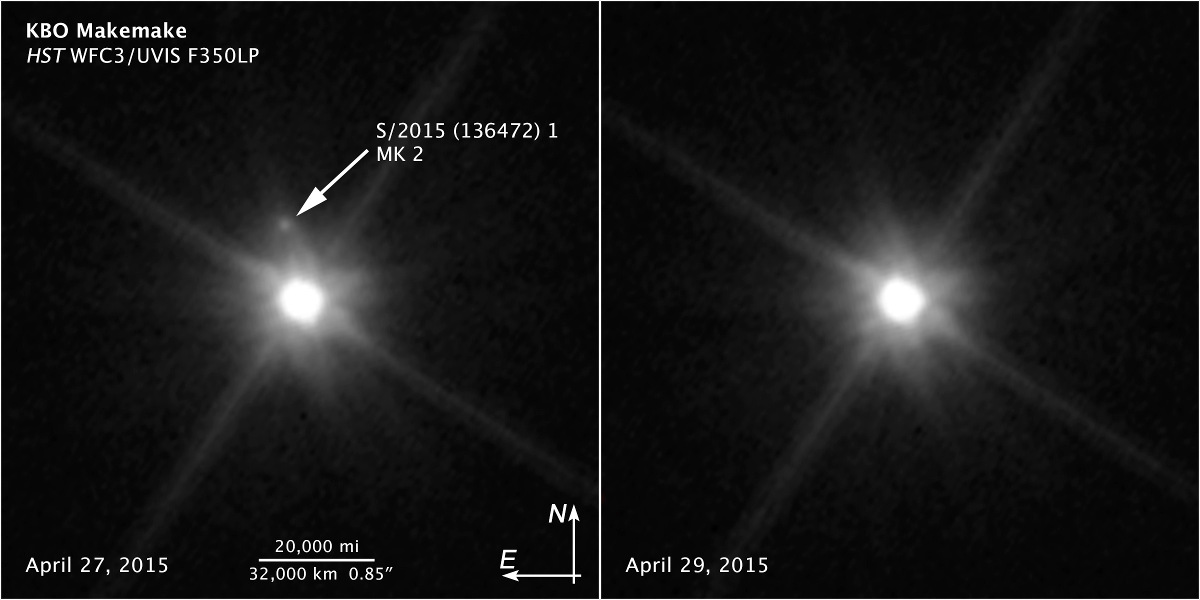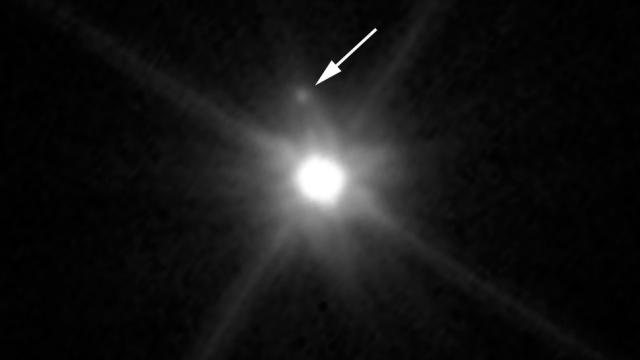Researchers working with the Hubble Space Telescope have discovered a moon in orbit around Makemake, a distant minor-planet that’s about two-thirds the size of Pluto.
Discovered in 2005, Makemake (pronounced mak-eh, mak-eh) is one of the brightest and largest objects in the Kuiper Belt. It’s one of several large trans-Neptunian objects (TNOs) known to astronomers, other notable examples being Pluto, Eris and Sedna. The dwarf planet, named after a creation deity of the Rapa Nui people of Easter Island, measures about 1400km wide, and features a bitterly cold surface covered with methane, ethane and possibly nitrogen gases. Makemake is 52.4AU from the sun (where 1AU equals the average distance of the Earth to the sun), whereas Pluto’s average distance is about 40AU.
Many dwarf planets have moons, so it comes as little surprise to learn that Makemake has one, too. Hubble scientists found the moon, nicknamed MK 2, about a year ago, but they only announced the discovery this week. The discovery was made by Alex Parker and pals from the Southwest Research Institute in Boulder, Colorado, and it was made possible using Hubble’s Wide Field Camera 3.
The newly discovered satellite — formally known as S/2015 (136472) 1 — is approximately 160km wide, and is parked in orbit some 21,000km from Makemake. Preliminary estimates place its orbital period at about a dozen days. This tight orbit suggests that MK 2 is probably the result of a collision between Makemake and another Kuiper belt object.

Image: NASA, ESA, and A. Parker (SwRI)
Unlike its relatively bright host (Makemake is the second-brightest Kuiper belt object after Pluto), MK 2 is incredibly dark — about 1300 times fainter than Makemake — so it basically resembles a chunk of floating charcoal. So why the stark difference in brightness? Astronomers believe the moon’s gravity isn’t strong enough to hold onto bright and icy surface materials that change from solid to gas when warmed by the sun. This means the moon is similar to comets and other Kuiper Belt objects, which tend to be covered by dark materials.
The discovery of MK 2 shows that Pluto and Makemake are quite similar. As team leader Marc Buie put it in a Hubble release, “This new discovery opens a new chapter in comparative planetology in the outer solar system.” In addition to hosting satellites, Pluto and Makemake also feature a surface covered in frozen methane. Looking ahead, the researchers would like to determine the density of Makemake, and to see if the newly discovered moon is in an elliptical or circular orbit.
[Hubble]
Image: NASA, ESA, and A. Parker (SwRI)
